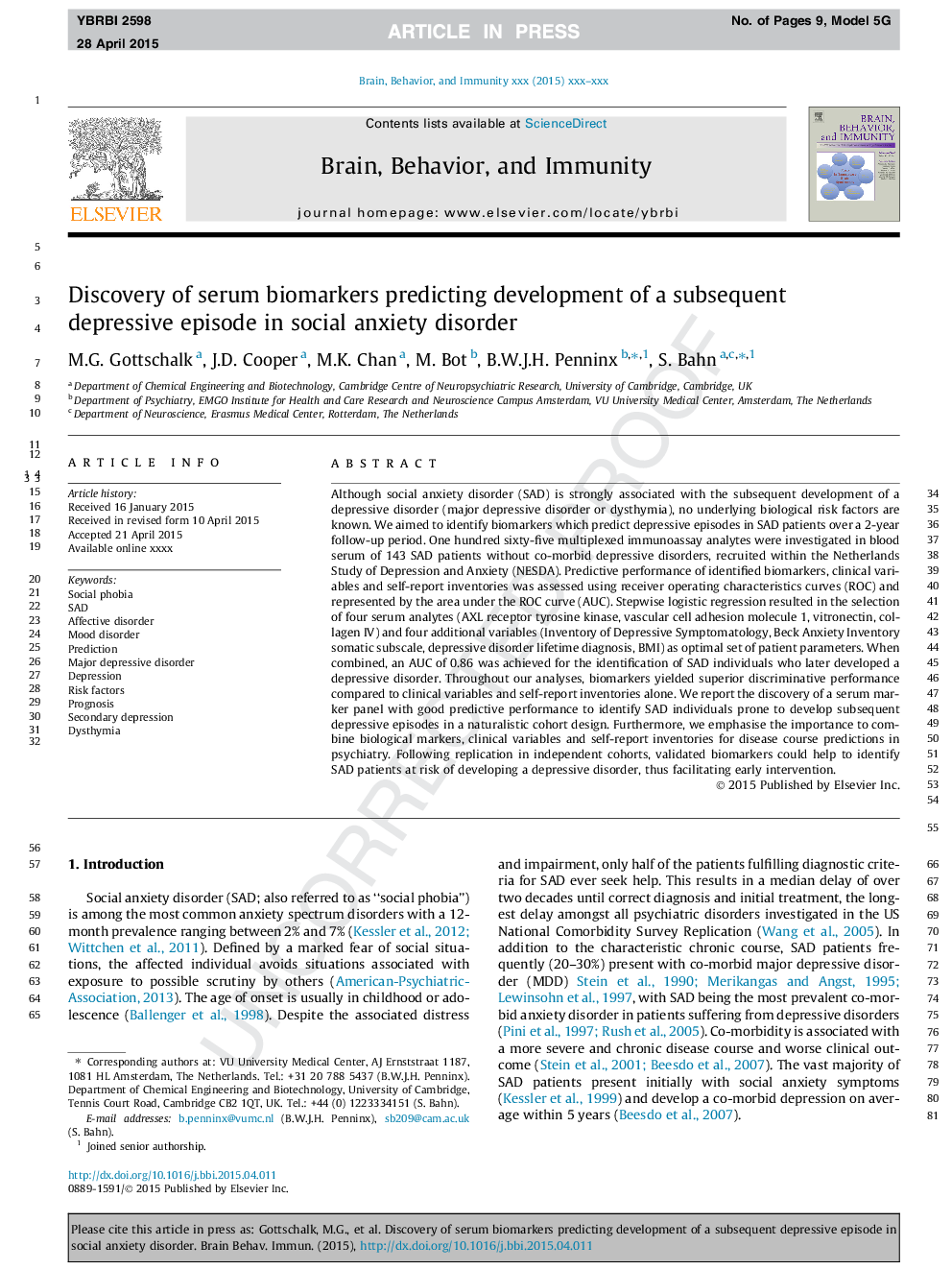| کد مقاله | کد نشریه | سال انتشار | مقاله انگلیسی | نسخه تمام متن |
|---|---|---|---|---|
| 7280957 | 1473919 | 2015 | 9 صفحه PDF | دانلود رایگان |
عنوان انگلیسی مقاله ISI
Discovery of serum biomarkers predicting development of a subsequent depressive episode in social anxiety disorder
ترجمه فارسی عنوان
کشف بیومارکرهای سرم پیش بینی توسعه یک قسمت افسردگی پس از اختلال اضطراب اجتماعی
دانلود مقاله + سفارش ترجمه
دانلود مقاله ISI انگلیسی
رایگان برای ایرانیان
کلمات کلیدی
فوبیایی اجتماعی، غمگین، اختلال عاطفی، اختلال خلقی، پیش بینی، اختلال افسردگی عمده، افسردگی، عوامل خطر، پیش بینی، افسردگی ثانویه، دیستیمیا،
موضوعات مرتبط
علوم زیستی و بیوفناوری
ایمنی شناسی و میکروب شناسی
ایمونولوژی
چکیده انگلیسی
Although social anxiety disorder (SAD) is strongly associated with the subsequent development of a depressive disorder (major depressive disorder or dysthymia), no underlying biological risk factors are known. We aimed to identify biomarkers which predict depressive episodes in SAD patients over a 2-year follow-up period. One hundred sixty-five multiplexed immunoassay analytes were investigated in blood serum of 143 SAD patients without co-morbid depressive disorders, recruited within the Netherlands Study of Depression and Anxiety (NESDA). Predictive performance of identified biomarkers, clinical variables and self-report inventories was assessed using receiver operating characteristics curves (ROC) and represented by the area under the ROC curve (AUC). Stepwise logistic regression resulted in the selection of four serum analytes (AXL receptor tyrosine kinase, vascular cell adhesion molecule 1, vitronectin, collagen IV) and four additional variables (Inventory of Depressive Symptomatology, Beck Anxiety Inventory somatic subscale, depressive disorder lifetime diagnosis, BMI) as optimal set of patient parameters. When combined, an AUC of 0.86 was achieved for the identification of SAD individuals who later developed a depressive disorder. Throughout our analyses, biomarkers yielded superior discriminative performance compared to clinical variables and self-report inventories alone. We report the discovery of a serum marker panel with good predictive performance to identify SAD individuals prone to develop subsequent depressive episodes in a naturalistic cohort design. Furthermore, we emphasise the importance to combine biological markers, clinical variables and self-report inventories for disease course predictions in psychiatry. Following replication in independent cohorts, validated biomarkers could help to identify SAD patients at risk of developing a depressive disorder, thus facilitating early intervention.
ناشر
Database: Elsevier - ScienceDirect (ساینس دایرکت)
Journal: Brain, Behavior, and Immunity - Volume 48, August 2015, Pages 123-131
Journal: Brain, Behavior, and Immunity - Volume 48, August 2015, Pages 123-131
نویسندگان
M.G. Gottschalk, J.D. Cooper, M.K. Chan, M. Bot, B.W.J.H. Penninx, S. Bahn,
